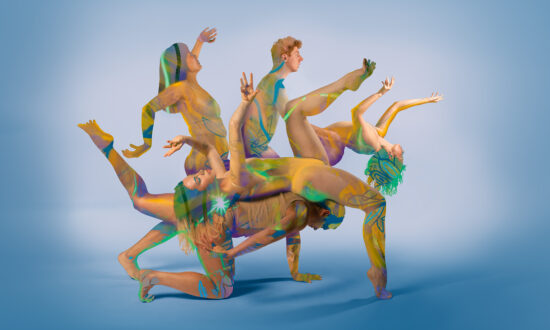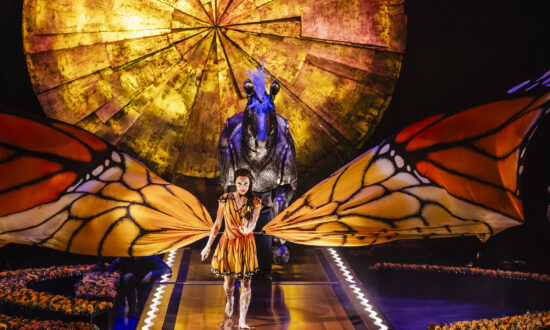With COVID-19 making it near-impossible to bring international acts here for this year’s Adelaide Festival, joint artistic directors Rachel Healy and Neil Armfield made it clear when they launched their program that the constraints had created opportunities for local artists and companies who would be presenting new work of a scale and ambition not previously seen.
One of those artists is Lewis Major, an Adelaide-based choreographer who grew up on a sheep farm between Penola and Robe and describes himself as having “a background in sheep shearing and a foreground in contemporary dance theatre”.
Major has his own company, Lewis Major Projects, and is this week presenting a double bill of two new works, Unfolding and S/WORDS, as part of the Festival program, while concurrently mounting a Fringe season of his 25-minute drive-in show Traffic in regional SA.

Choreographer Lewis Major.
While he has been working for a couple of years on S/WORDS, which sees a “flung-together” group of performers locked in a theatre as the world burns outside, Unfolding, which is performed by 12 dancers and features shifting 3D animations, began as a lockdown project during the global pandemic. Major and his collaborators, composer/sound designer James Brown and lighting designer Fausto Brusamolino, were still in the early stages of developing Unfolding when the Festival came calling, but he didn’t hesitate before replying: “I’ve got a show for you.”
It’s indicative of the drive, determination and confidence that have helped Major develop a successful dance career which has seen him work with top choreographers and present work in countries including the UK, France, Brazil, Hong Kong, Luxembourg and Mexico – all despite being diagnosed with a degenerative back condition at just 21.
“I was a very sporty kid, chasing sheep and playing footy – essentially I am country – but I was also a sensitive kid and I was into art,” he tells InReview, discussing his early life.
It was while attending boarding school in Adelaide that he became involved in drama and then – after being asked to play the role of a “human crane” lifting a female dancer from one place to another in a SACE dance performance – discovered an interest in dance. He became obsessed with the artform, skipping Year 12 lessons to attend dance classes and reading and watching everything he could about dance.
“I basically graduated high school and was enrolled to do law and then turned around and said, ‘I’m going to be a dancer’. I was an academic kid but I had more important things to worry about – like stretching and getting flexible.”
After school Major did two years of full-time training in Adelaide, then went on to the New Zealand School of Dance in Wellington. In his second year, however, he started suffering persistent back pain.
“It was like a dull ache and I’d have good days and bad days, and when you’re young you kind of just fight through it, but on my 21st birthday I got some results back from a scan I’d had and I had stress fractures all down my back.”
It turned out Major had a degenerative back condition that was aggravated by his intensely physical training regime, but he was determined to continue. Then, midway through his third year of training in New Zealand, he went to Europe on a trip that proved pivotal in his career.
My work is just a mirror that I hold up to the audience
In Vienna, Austria, amidst a big dance festival, he met a Belgian choreographer and ended up performing in his dance-theatre show in the historic Café Prückel. It was, Major says, typical European-style dance, with “lots of theatrical states, lots of emoting and this beautiful incredible dancing”.
“It was great fun… let’s just say it was nutty and amazing.”
By 2010, he was living in Amsterdam where he had another serendipitous meeting, this time with a friend of his flatmate called Aakash Odedra, a Kathak dancer.
“One day out of the blue, I was doing my training in the morning and Aakash [who was trained in classical Indian dance] was sitting on the stairs watching me and he said, ‘Hey, can you teach me some of that?’”
Odedra invited Major to help with the new company he was starting in the UK, the Aakash Odedra Company.
“We started making a work called Rising, which premiered at the end of December 2011 and is still going today.”
Rising is a solo show – it was presented at the OzAsia Festival in Adelaide in 2017 – and Major was both an understudy and rehearsal directing Odedra as a choreographic assistant to the three choreographers who worked on it.
“My back kind of put a stop to my performance career,” he says. “I could still dance but if I had a bad turn with my back in the middle of the creation period I couldn’t continue.”
He ended up living and working in Europe for about six years. While there, he also met his now wife, Diane, a fellow dancer, and choreographed some of his own dance works, including one that was funded through the Kevin Spacey Foundation and presented at the prestigious Sadler’s Wells Theatre in London.

Dancers in Unfolding, which began as a lockdown project. Photo: Chris Herzfeld
Missing Australia, Major eventually returned home with Diane. After a brief return to sheep farming – “I was tired and sore and exhausted and I couldn’t see any trajectory” – he moved to Adelaide with fresh determination and restarted Lewis Major Projects, producing and toured the solo work Epilogue, as well as works in regional SA.
Major says collaboration is “vital to my creative process”.
“My ideal way to make a show is to get my composer, my sound designer, my lighting designer, and fashion designer, if we have one, into a theatre with the dancers and say, ‘Right, go!’, and we’ll just play for a week. I have such gratitude to be able to do that.”
Unfolding was born in the middle of the COVID-19 lockdown, when Italian lighting designer Fausto Brusamolino, composer James Brown and Major began devising shows in a 3D environment that was coded in a video game lab.
“So we basically made theatre in a video game and I had a motion-tracking suit and I was putting motion-tracking data in there and James was composing music on top of it and Fausto was changing the lights. It was what we would normally do in a theatre but we were doing it online because we were isolating during COVID.”
When the three were finally able to gather together in a theatre and start working with visual projections that reacted to dancers’ movement and sound, Major was struck by “how much of the most valuable and distant currency of our time, touch, played in the choreography”.
Unfolding will open his double bill at the Adelaide Festival Centre’s Space Theatre this week, and is being performed by four dancers – Clementine Benson, Sam Hall, Stefaan Morrow and Sarah Wilson – with costumes designed by Naomi Murrell Studios.
The same dancers are among the 12 who then perform in S/WORDS, which was created with dramaturg Lou Cope and also seems to resonate with the current challenging times even though the idea was conceived pre-pandemic and before the devastating bushfires of last summer.
“It sort of started with the central conceit that the world is on fire outside and there are a group of people who are locked in the theatre and they can’t speak to each other and they’re trying to negotiate the making of a show,” Major says.
“It’s like the last show to end the world – the swansong, the party as the Titanic sinks. But at the same time, it’s a metaphor for building the new society that we’d like to have… what are the things you keep, what are the traditions and the rituals, what are the things we’re holding onto.
“It feels like an important work and something that could be quite cathartic.”
Major is acutely aware some people can be put off by contemporary dance if they feel they can’t grasp what is happening. His website states Lewis Major Projects “steadfastly reject opaqueness in what we put on stage and our work is unabashedly audience-driven”.
“The arts are not supposed to be this elevated, wanky thing – I try to make art for people,” he says. “The audience experience comes first.
“I had a great mentor who was a director at the National Theatre in London and he said the perfect show was a balance between form and function: What is the purpose of this art, what is it trying to say, what does it represent, what kind of mirror is it showing? My work is just a mirror that I hold up to the audience and say, ‘This is what you look like – if you don’t like it, why don’t you try to change it?”
Ultimately, though, he believes watching contemporary dance should be an enjoyable and moving experience – and that’s what he hopes to achieve with both S/WORDS and Unfolding.
“You’ll know when you see art that is transcendental… as a performing art it should be for other people, not for your own sense of self.”
Lewis Major’s double bill Unfolding and S/WORDS is being presented at the Adelaide Festival Centre’s Space Theatre from March 11-14 as part of the Adelaide Festival.
Read more Adelaide Festival stories and reviews here.
Support local arts journalism
Your support will help us continue the important work of InReview in publishing free professional journalism that celebrates, interrogates and amplifies arts and culture in South Australia.
Donate Here



